Forensic Science: La Trobe Valley Court Visit and Crime Evidence
VerifiedAdded on 2023/06/11
|9
|2205
|173
Case Study
AI Summary
This forensic science case study details a visit to the La Trobe Valley Magistrates Court, focusing on a workers' compensation case. It covers court etiquette, observations of the magistrate's conduct, and the roles of various court personnel. The study also explains technical concepts like mass spectrometry and layer chromatography in layman's terms. Furthermore, it discusses Dr. Edmond Locard's exchange principle, applying it to a hypothetical crime scene involving a murder, analyzing the strength and relevance of different pieces of evidence like a hammer, fibers, camera images, and DNA analysis to link suspects to the crime. The assignment concludes by evaluating the robustness of each piece of evidence in establishing the suspects' involvement.
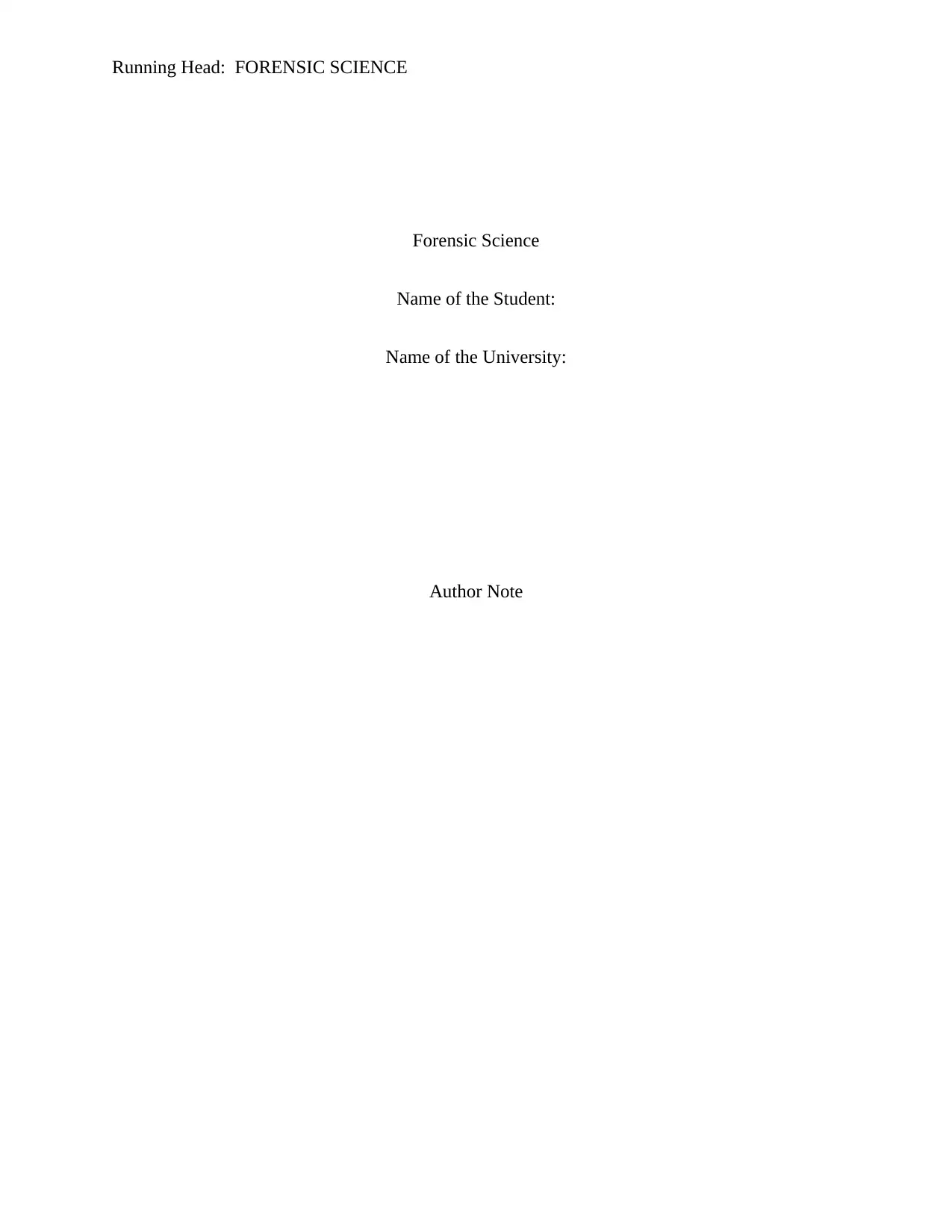
Running Head: FORENSIC SCIENCE
Forensic Science
Name of the Student:
Name of the University:
Author Note
Forensic Science
Name of the Student:
Name of the University:
Author Note
Paraphrase This Document
Need a fresh take? Get an instant paraphrase of this document with our AI Paraphraser
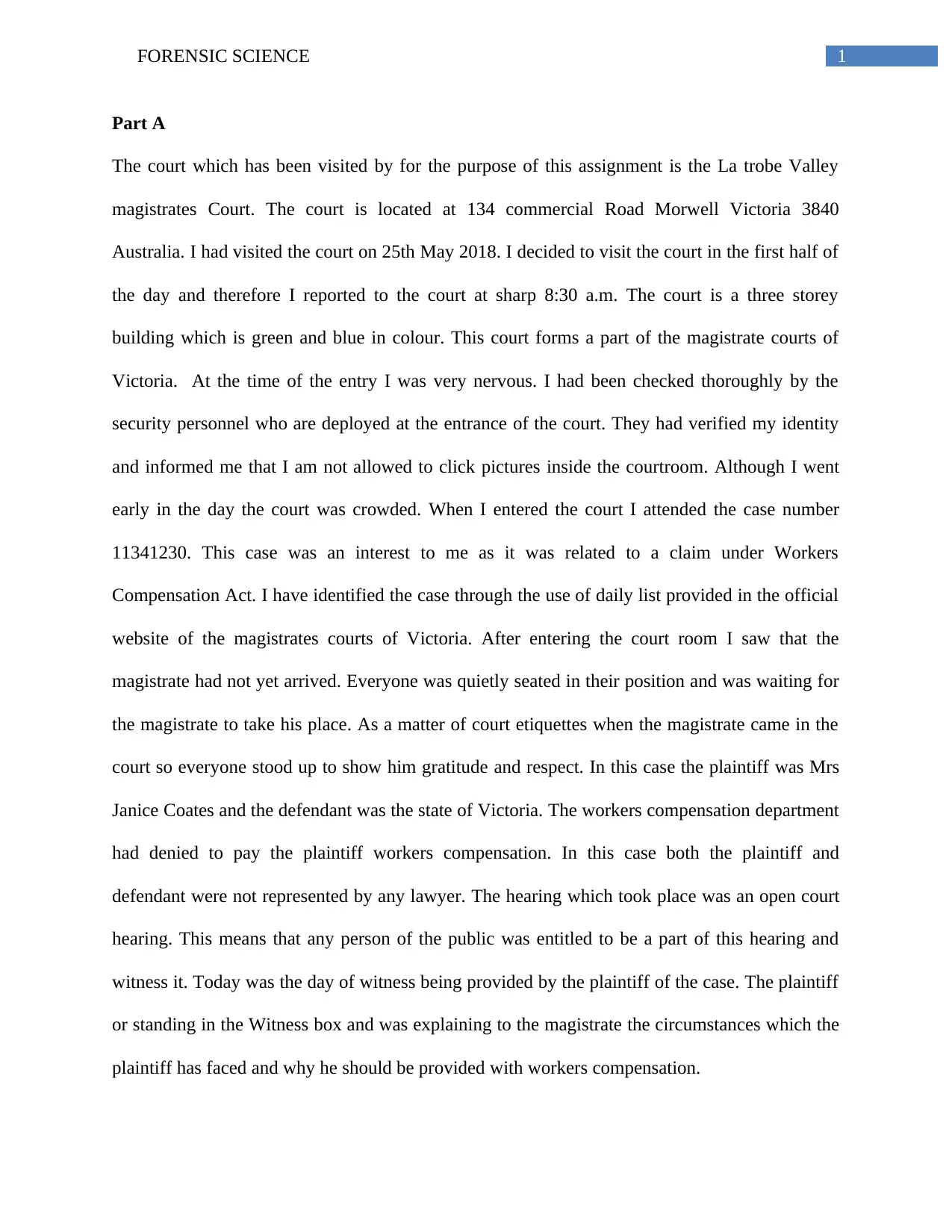
1FORENSIC SCIENCE
Part A
The court which has been visited by for the purpose of this assignment is the La trobe Valley
magistrates Court. The court is located at 134 commercial Road Morwell Victoria 3840
Australia. I had visited the court on 25th May 2018. I decided to visit the court in the first half of
the day and therefore I reported to the court at sharp 8:30 a.m. The court is a three storey
building which is green and blue in colour. This court forms a part of the magistrate courts of
Victoria. At the time of the entry I was very nervous. I had been checked thoroughly by the
security personnel who are deployed at the entrance of the court. They had verified my identity
and informed me that I am not allowed to click pictures inside the courtroom. Although I went
early in the day the court was crowded. When I entered the court I attended the case number
11341230. This case was an interest to me as it was related to a claim under Workers
Compensation Act. I have identified the case through the use of daily list provided in the official
website of the magistrates courts of Victoria. After entering the court room I saw that the
magistrate had not yet arrived. Everyone was quietly seated in their position and was waiting for
the magistrate to take his place. As a matter of court etiquettes when the magistrate came in the
court so everyone stood up to show him gratitude and respect. In this case the plaintiff was Mrs
Janice Coates and the defendant was the state of Victoria. The workers compensation department
had denied to pay the plaintiff workers compensation. In this case both the plaintiff and
defendant were not represented by any lawyer. The hearing which took place was an open court
hearing. This means that any person of the public was entitled to be a part of this hearing and
witness it. Today was the day of witness being provided by the plaintiff of the case. The plaintiff
or standing in the Witness box and was explaining to the magistrate the circumstances which the
plaintiff has faced and why he should be provided with workers compensation.
Part A
The court which has been visited by for the purpose of this assignment is the La trobe Valley
magistrates Court. The court is located at 134 commercial Road Morwell Victoria 3840
Australia. I had visited the court on 25th May 2018. I decided to visit the court in the first half of
the day and therefore I reported to the court at sharp 8:30 a.m. The court is a three storey
building which is green and blue in colour. This court forms a part of the magistrate courts of
Victoria. At the time of the entry I was very nervous. I had been checked thoroughly by the
security personnel who are deployed at the entrance of the court. They had verified my identity
and informed me that I am not allowed to click pictures inside the courtroom. Although I went
early in the day the court was crowded. When I entered the court I attended the case number
11341230. This case was an interest to me as it was related to a claim under Workers
Compensation Act. I have identified the case through the use of daily list provided in the official
website of the magistrates courts of Victoria. After entering the court room I saw that the
magistrate had not yet arrived. Everyone was quietly seated in their position and was waiting for
the magistrate to take his place. As a matter of court etiquettes when the magistrate came in the
court so everyone stood up to show him gratitude and respect. In this case the plaintiff was Mrs
Janice Coates and the defendant was the state of Victoria. The workers compensation department
had denied to pay the plaintiff workers compensation. In this case both the plaintiff and
defendant were not represented by any lawyer. The hearing which took place was an open court
hearing. This means that any person of the public was entitled to be a part of this hearing and
witness it. Today was the day of witness being provided by the plaintiff of the case. The plaintiff
or standing in the Witness box and was explaining to the magistrate the circumstances which the
plaintiff has faced and why he should be provided with workers compensation.
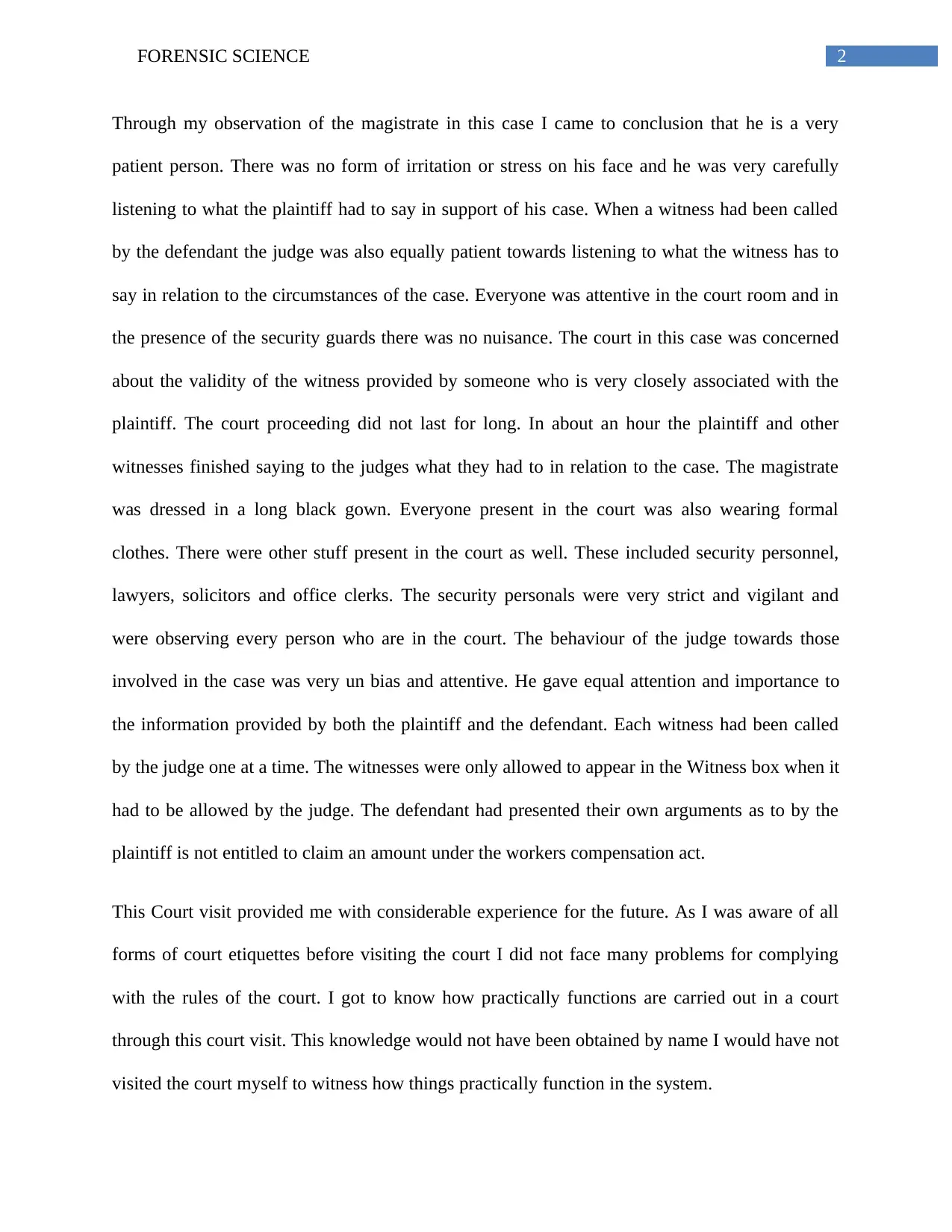
2FORENSIC SCIENCE
Through my observation of the magistrate in this case I came to conclusion that he is a very
patient person. There was no form of irritation or stress on his face and he was very carefully
listening to what the plaintiff had to say in support of his case. When a witness had been called
by the defendant the judge was also equally patient towards listening to what the witness has to
say in relation to the circumstances of the case. Everyone was attentive in the court room and in
the presence of the security guards there was no nuisance. The court in this case was concerned
about the validity of the witness provided by someone who is very closely associated with the
plaintiff. The court proceeding did not last for long. In about an hour the plaintiff and other
witnesses finished saying to the judges what they had to in relation to the case. The magistrate
was dressed in a long black gown. Everyone present in the court was also wearing formal
clothes. There were other stuff present in the court as well. These included security personnel,
lawyers, solicitors and office clerks. The security personals were very strict and vigilant and
were observing every person who are in the court. The behaviour of the judge towards those
involved in the case was very un bias and attentive. He gave equal attention and importance to
the information provided by both the plaintiff and the defendant. Each witness had been called
by the judge one at a time. The witnesses were only allowed to appear in the Witness box when it
had to be allowed by the judge. The defendant had presented their own arguments as to by the
plaintiff is not entitled to claim an amount under the workers compensation act.
This Court visit provided me with considerable experience for the future. As I was aware of all
forms of court etiquettes before visiting the court I did not face many problems for complying
with the rules of the court. I got to know how practically functions are carried out in a court
through this court visit. This knowledge would not have been obtained by name I would have not
visited the court myself to witness how things practically function in the system.
Through my observation of the magistrate in this case I came to conclusion that he is a very
patient person. There was no form of irritation or stress on his face and he was very carefully
listening to what the plaintiff had to say in support of his case. When a witness had been called
by the defendant the judge was also equally patient towards listening to what the witness has to
say in relation to the circumstances of the case. Everyone was attentive in the court room and in
the presence of the security guards there was no nuisance. The court in this case was concerned
about the validity of the witness provided by someone who is very closely associated with the
plaintiff. The court proceeding did not last for long. In about an hour the plaintiff and other
witnesses finished saying to the judges what they had to in relation to the case. The magistrate
was dressed in a long black gown. Everyone present in the court was also wearing formal
clothes. There were other stuff present in the court as well. These included security personnel,
lawyers, solicitors and office clerks. The security personals were very strict and vigilant and
were observing every person who are in the court. The behaviour of the judge towards those
involved in the case was very un bias and attentive. He gave equal attention and importance to
the information provided by both the plaintiff and the defendant. Each witness had been called
by the judge one at a time. The witnesses were only allowed to appear in the Witness box when it
had to be allowed by the judge. The defendant had presented their own arguments as to by the
plaintiff is not entitled to claim an amount under the workers compensation act.
This Court visit provided me with considerable experience for the future. As I was aware of all
forms of court etiquettes before visiting the court I did not face many problems for complying
with the rules of the court. I got to know how practically functions are carried out in a court
through this court visit. This knowledge would not have been obtained by name I would have not
visited the court myself to witness how things practically function in the system.
⊘ This is a preview!⊘
Do you want full access?
Subscribe today to unlock all pages.

Trusted by 1+ million students worldwide
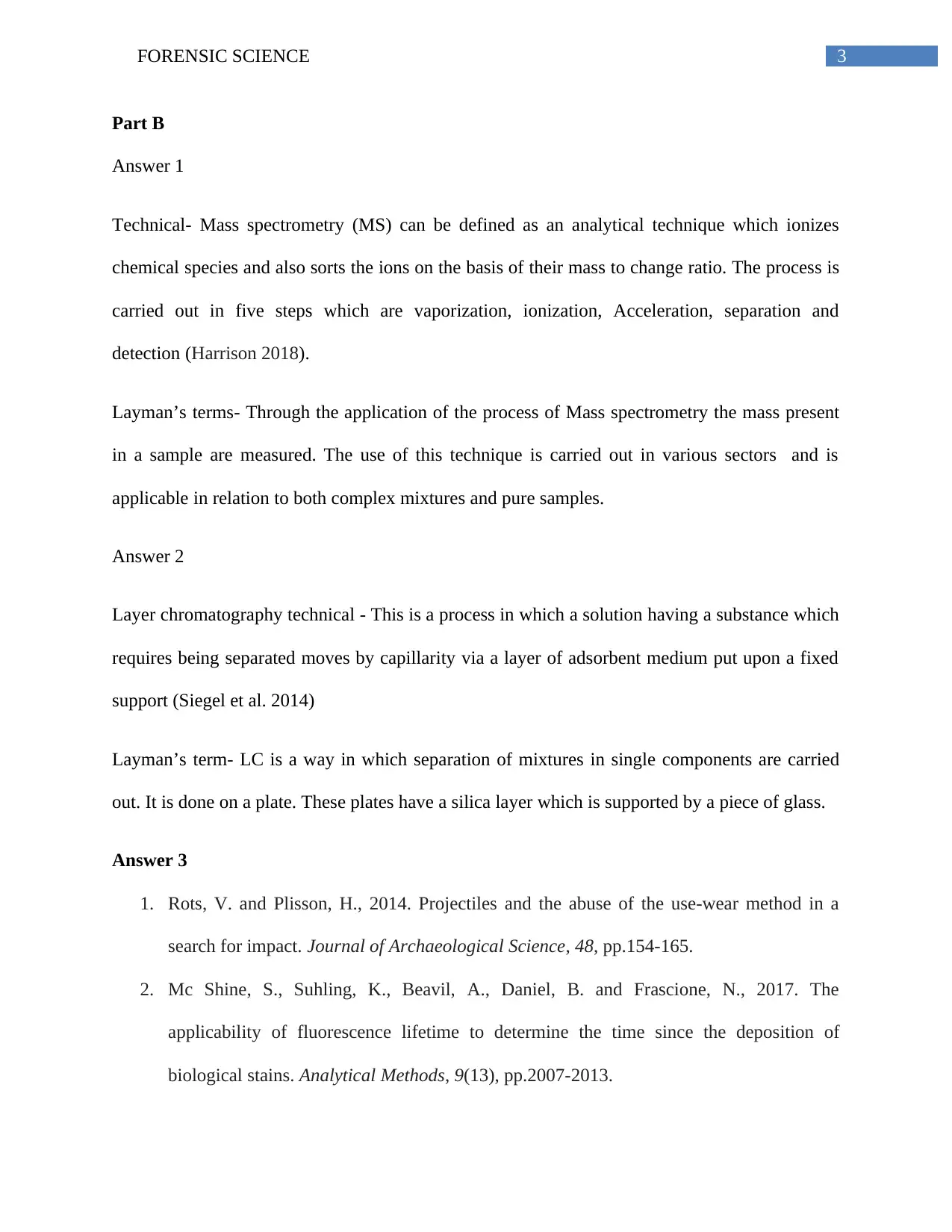
3FORENSIC SCIENCE
Part B
Answer 1
Technical- Mass spectrometry (MS) can be defined as an analytical technique which ionizes
chemical species and also sorts the ions on the basis of their mass to change ratio. The process is
carried out in five steps which are vaporization, ionization, Acceleration, separation and
detection (Harrison 2018).
Layman’s terms- Through the application of the process of Mass spectrometry the mass present
in a sample are measured. The use of this technique is carried out in various sectors and is
applicable in relation to both complex mixtures and pure samples.
Answer 2
Layer chromatography technical - This is a process in which a solution having a substance which
requires being separated moves by capillarity via a layer of adsorbent medium put upon a fixed
support (Siegel et al. 2014)
Layman’s term- LC is a way in which separation of mixtures in single components are carried
out. It is done on a plate. These plates have a silica layer which is supported by a piece of glass.
Answer 3
1. Rots, V. and Plisson, H., 2014. Projectiles and the abuse of the use-wear method in a
search for impact. Journal of Archaeological Science, 48, pp.154-165.
2. Mc Shine, S., Suhling, K., Beavil, A., Daniel, B. and Frascione, N., 2017. The
applicability of fluorescence lifetime to determine the time since the deposition of
biological stains. Analytical Methods, 9(13), pp.2007-2013.
Part B
Answer 1
Technical- Mass spectrometry (MS) can be defined as an analytical technique which ionizes
chemical species and also sorts the ions on the basis of their mass to change ratio. The process is
carried out in five steps which are vaporization, ionization, Acceleration, separation and
detection (Harrison 2018).
Layman’s terms- Through the application of the process of Mass spectrometry the mass present
in a sample are measured. The use of this technique is carried out in various sectors and is
applicable in relation to both complex mixtures and pure samples.
Answer 2
Layer chromatography technical - This is a process in which a solution having a substance which
requires being separated moves by capillarity via a layer of adsorbent medium put upon a fixed
support (Siegel et al. 2014)
Layman’s term- LC is a way in which separation of mixtures in single components are carried
out. It is done on a plate. These plates have a silica layer which is supported by a piece of glass.
Answer 3
1. Rots, V. and Plisson, H., 2014. Projectiles and the abuse of the use-wear method in a
search for impact. Journal of Archaeological Science, 48, pp.154-165.
2. Mc Shine, S., Suhling, K., Beavil, A., Daniel, B. and Frascione, N., 2017. The
applicability of fluorescence lifetime to determine the time since the deposition of
biological stains. Analytical Methods, 9(13), pp.2007-2013.
Paraphrase This Document
Need a fresh take? Get an instant paraphrase of this document with our AI Paraphraser
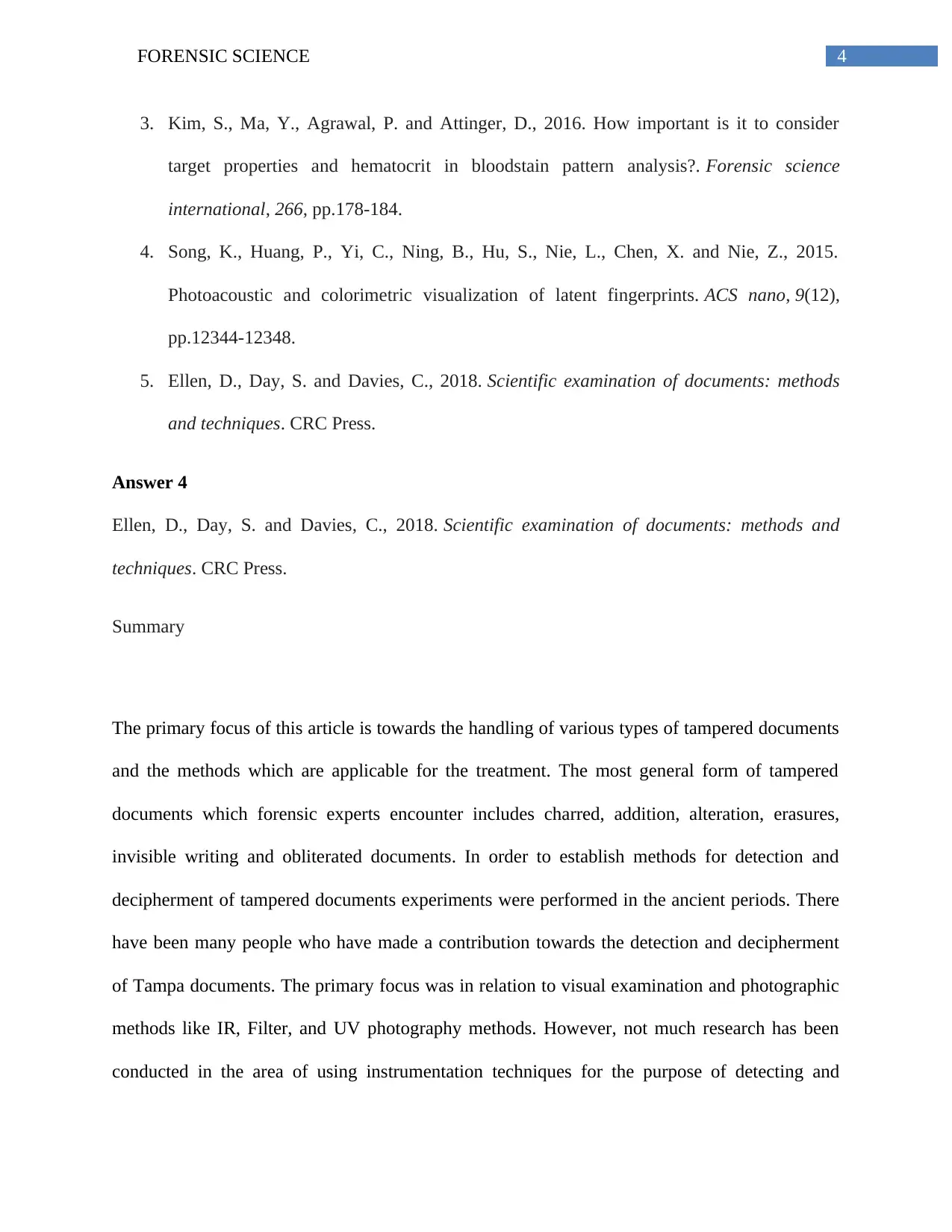
4FORENSIC SCIENCE
3. Kim, S., Ma, Y., Agrawal, P. and Attinger, D., 2016. How important is it to consider
target properties and hematocrit in bloodstain pattern analysis?. Forensic science
international, 266, pp.178-184.
4. Song, K., Huang, P., Yi, C., Ning, B., Hu, S., Nie, L., Chen, X. and Nie, Z., 2015.
Photoacoustic and colorimetric visualization of latent fingerprints. ACS nano, 9(12),
pp.12344-12348.
5. Ellen, D., Day, S. and Davies, C., 2018. Scientific examination of documents: methods
and techniques. CRC Press.
Answer 4
Ellen, D., Day, S. and Davies, C., 2018. Scientific examination of documents: methods and
techniques. CRC Press.
Summary
The primary focus of this article is towards the handling of various types of tampered documents
and the methods which are applicable for the treatment. The most general form of tampered
documents which forensic experts encounter includes charred, addition, alteration, erasures,
invisible writing and obliterated documents. In order to establish methods for detection and
decipherment of tampered documents experiments were performed in the ancient periods. There
have been many people who have made a contribution towards the detection and decipherment
of Tampa documents. The primary focus was in relation to visual examination and photographic
methods like IR, Filter, and UV photography methods. However, not much research has been
conducted in the area of using instrumentation techniques for the purpose of detecting and
3. Kim, S., Ma, Y., Agrawal, P. and Attinger, D., 2016. How important is it to consider
target properties and hematocrit in bloodstain pattern analysis?. Forensic science
international, 266, pp.178-184.
4. Song, K., Huang, P., Yi, C., Ning, B., Hu, S., Nie, L., Chen, X. and Nie, Z., 2015.
Photoacoustic and colorimetric visualization of latent fingerprints. ACS nano, 9(12),
pp.12344-12348.
5. Ellen, D., Day, S. and Davies, C., 2018. Scientific examination of documents: methods
and techniques. CRC Press.
Answer 4
Ellen, D., Day, S. and Davies, C., 2018. Scientific examination of documents: methods and
techniques. CRC Press.
Summary
The primary focus of this article is towards the handling of various types of tampered documents
and the methods which are applicable for the treatment. The most general form of tampered
documents which forensic experts encounter includes charred, addition, alteration, erasures,
invisible writing and obliterated documents. In order to establish methods for detection and
decipherment of tampered documents experiments were performed in the ancient periods. There
have been many people who have made a contribution towards the detection and decipherment
of Tampa documents. The primary focus was in relation to visual examination and photographic
methods like IR, Filter, and UV photography methods. However, not much research has been
conducted in the area of using instrumentation techniques for the purpose of detecting and

5FORENSIC SCIENCE
decipherment of tampered documents. There are many inks which are used for criminal and
fraudulent purpose and in relation to such facts the use of invisible ink is becoming popular day
by day. Due to the advancement in the technology there are various analytical ways which are
present and can be used for the purpose of identifying source of data of a specific paper or ink.
The article provides information in relation to the methods available for the decipherment of
tampered documents which includes advanced instrumentation techniques as well as common
methods. The paper provides discussions about how useful search methods can be in relation to
forensic experts who have the role of decoding are tampered document in order to collect
evidence. The paper successfully identifies how common methods and advanced instrumentation
techniques can be used together for best results.
Part C
Answer 1
It has been provided by the exchange principles of Dr Edmond Locard that even where human
witness is absent Physical evidence is always present to find out who has committed the crime.
The value of such evidence can only be reduced if there is human error with respect to finding
such evidence and understanding it. Whenever a person comes into a Crime Scene he leaves
something and take something from the scene. Physical evidence may include anything which is
touched by the crime preparatory or anything which has been in his contact. This not only
includes fingerprints or footprints but also evidence like semen samples, hair, fibers from cloth,
any mark of tools, scratches on the wall and broken glasses. All these evidence will silently
provide witness against the criminal (Robertson, Roux and Wiggins 2017).
Answer 2
decipherment of tampered documents. There are many inks which are used for criminal and
fraudulent purpose and in relation to such facts the use of invisible ink is becoming popular day
by day. Due to the advancement in the technology there are various analytical ways which are
present and can be used for the purpose of identifying source of data of a specific paper or ink.
The article provides information in relation to the methods available for the decipherment of
tampered documents which includes advanced instrumentation techniques as well as common
methods. The paper provides discussions about how useful search methods can be in relation to
forensic experts who have the role of decoding are tampered document in order to collect
evidence. The paper successfully identifies how common methods and advanced instrumentation
techniques can be used together for best results.
Part C
Answer 1
It has been provided by the exchange principles of Dr Edmond Locard that even where human
witness is absent Physical evidence is always present to find out who has committed the crime.
The value of such evidence can only be reduced if there is human error with respect to finding
such evidence and understanding it. Whenever a person comes into a Crime Scene he leaves
something and take something from the scene. Physical evidence may include anything which is
touched by the crime preparatory or anything which has been in his contact. This not only
includes fingerprints or footprints but also evidence like semen samples, hair, fibers from cloth,
any mark of tools, scratches on the wall and broken glasses. All these evidence will silently
provide witness against the criminal (Robertson, Roux and Wiggins 2017).
Answer 2
⊘ This is a preview!⊘
Do you want full access?
Subscribe today to unlock all pages.

Trusted by 1+ million students worldwide
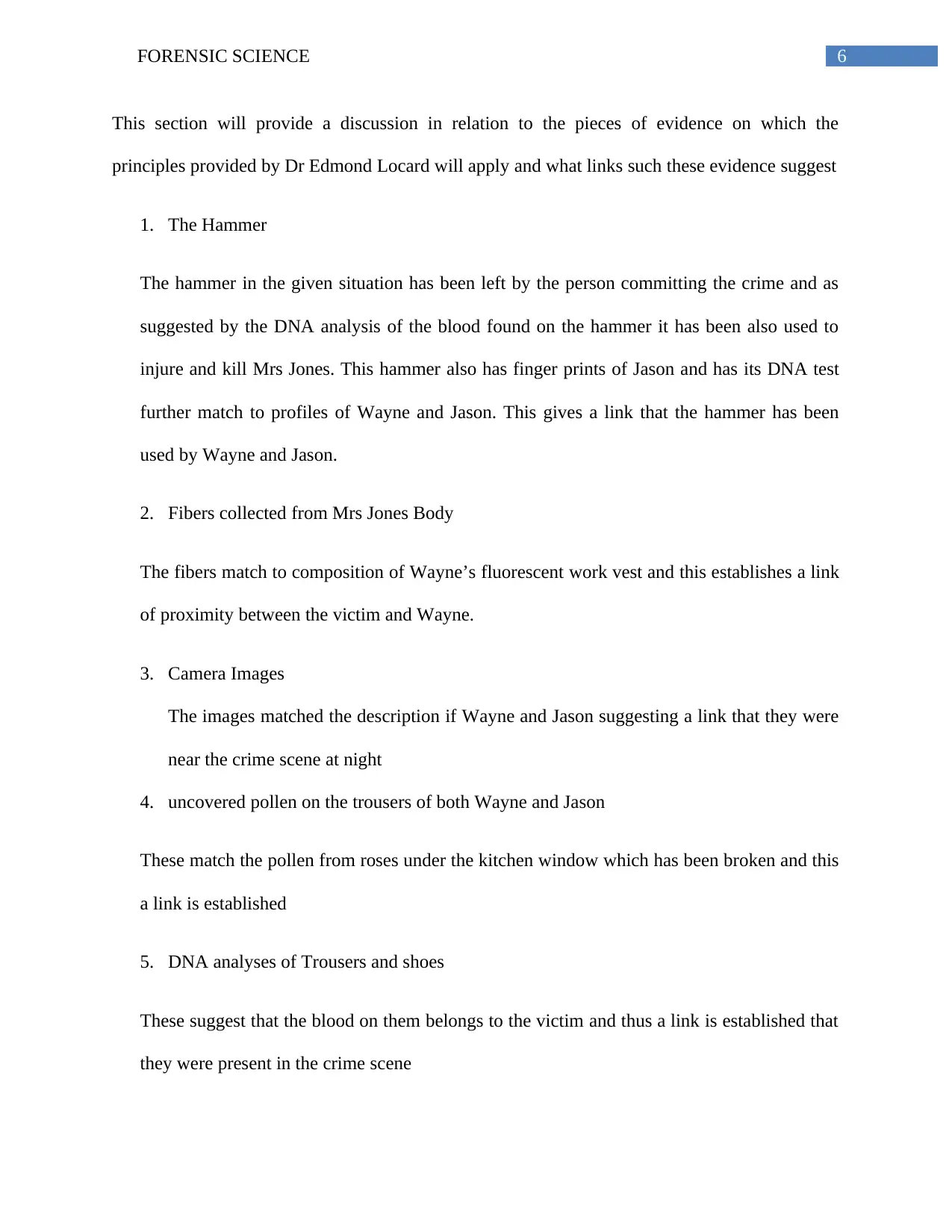
6FORENSIC SCIENCE
This section will provide a discussion in relation to the pieces of evidence on which the
principles provided by Dr Edmond Locard will apply and what links such these evidence suggest
1. The Hammer
The hammer in the given situation has been left by the person committing the crime and as
suggested by the DNA analysis of the blood found on the hammer it has been also used to
injure and kill Mrs Jones. This hammer also has finger prints of Jason and has its DNA test
further match to profiles of Wayne and Jason. This gives a link that the hammer has been
used by Wayne and Jason.
2. Fibers collected from Mrs Jones Body
The fibers match to composition of Wayne’s fluorescent work vest and this establishes a link
of proximity between the victim and Wayne.
3. Camera Images
The images matched the description if Wayne and Jason suggesting a link that they were
near the crime scene at night
4. uncovered pollen on the trousers of both Wayne and Jason
These match the pollen from roses under the kitchen window which has been broken and this
a link is established
5. DNA analyses of Trousers and shoes
These suggest that the blood on them belongs to the victim and thus a link is established that
they were present in the crime scene
This section will provide a discussion in relation to the pieces of evidence on which the
principles provided by Dr Edmond Locard will apply and what links such these evidence suggest
1. The Hammer
The hammer in the given situation has been left by the person committing the crime and as
suggested by the DNA analysis of the blood found on the hammer it has been also used to
injure and kill Mrs Jones. This hammer also has finger prints of Jason and has its DNA test
further match to profiles of Wayne and Jason. This gives a link that the hammer has been
used by Wayne and Jason.
2. Fibers collected from Mrs Jones Body
The fibers match to composition of Wayne’s fluorescent work vest and this establishes a link
of proximity between the victim and Wayne.
3. Camera Images
The images matched the description if Wayne and Jason suggesting a link that they were
near the crime scene at night
4. uncovered pollen on the trousers of both Wayne and Jason
These match the pollen from roses under the kitchen window which has been broken and this
a link is established
5. DNA analyses of Trousers and shoes
These suggest that the blood on them belongs to the victim and thus a link is established that
they were present in the crime scene
Paraphrase This Document
Need a fresh take? Get an instant paraphrase of this document with our AI Paraphraser

7FORENSIC SCIENCE
Answer three
The evidence related to hammer is very strong. This is because the hamner has finger prints of
Jason and also DNA related to Wayne. The hammer has been used to kill the victim as the blood
on its head matches the blood of the victim. This it is clear that Wayne and Jason used the
hamper to kill Mrs Jones
The Fibers from Mrs Jones body are not a very strong evidence as Wayne was working in her
house and such finder may have come coincidently.
The camera evidence is very strong as its links up with the above hammer and fiber evidence to
show that Wayne and Jason went to the crime scene
The uncovered pollen on the trousers of both Wayne and Jason and DNA analyses of Trousers
and shoes makes it very clear that Wayne and Jason were present at the crime scene.
Answer three
The evidence related to hammer is very strong. This is because the hamner has finger prints of
Jason and also DNA related to Wayne. The hammer has been used to kill the victim as the blood
on its head matches the blood of the victim. This it is clear that Wayne and Jason used the
hamper to kill Mrs Jones
The Fibers from Mrs Jones body are not a very strong evidence as Wayne was working in her
house and such finder may have come coincidently.
The camera evidence is very strong as its links up with the above hammer and fiber evidence to
show that Wayne and Jason went to the crime scene
The uncovered pollen on the trousers of both Wayne and Jason and DNA analyses of Trousers
and shoes makes it very clear that Wayne and Jason were present at the crime scene.
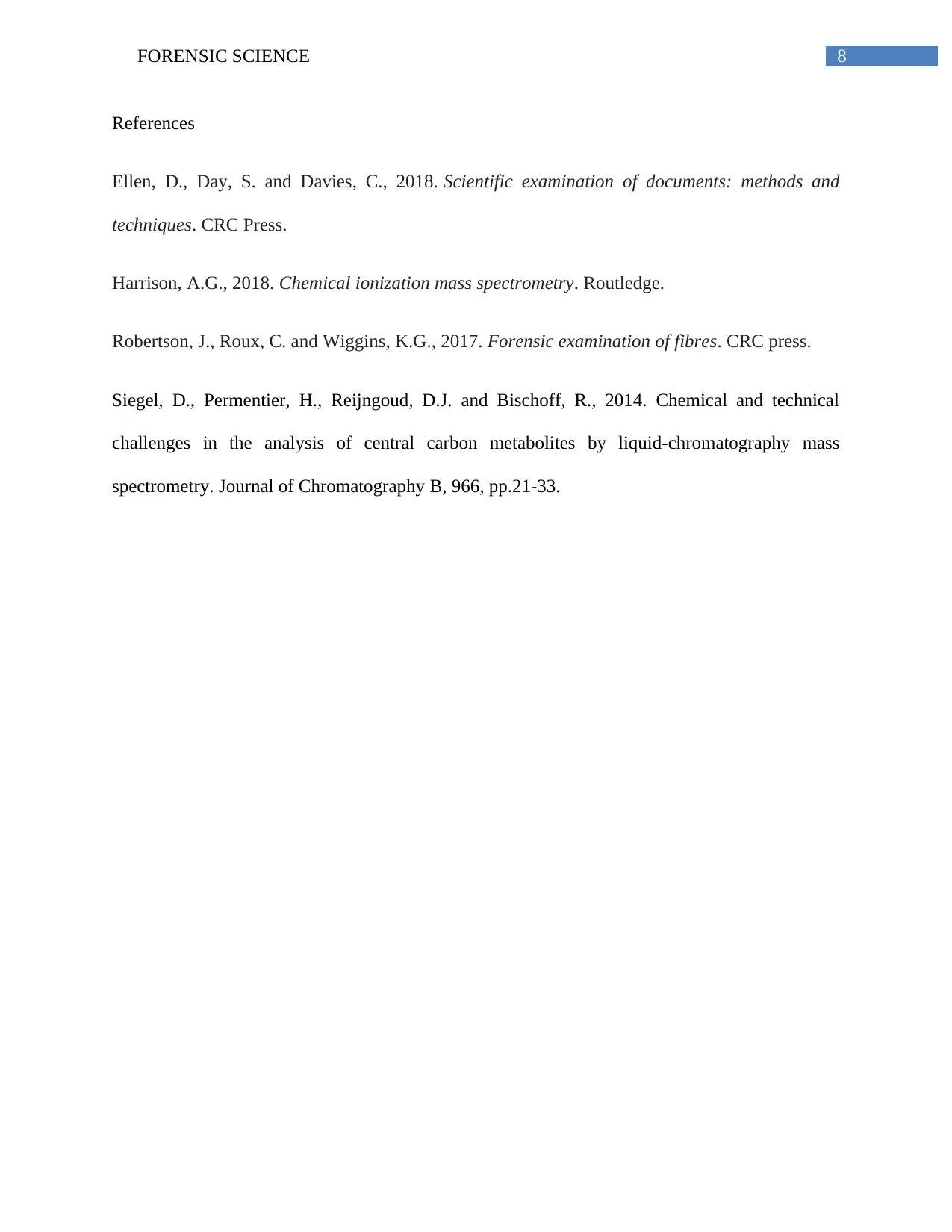
8FORENSIC SCIENCE
References
Ellen, D., Day, S. and Davies, C., 2018. Scientific examination of documents: methods and
techniques. CRC Press.
Harrison, A.G., 2018. Chemical ionization mass spectrometry. Routledge.
Robertson, J., Roux, C. and Wiggins, K.G., 2017. Forensic examination of fibres. CRC press.
Siegel, D., Permentier, H., Reijngoud, D.J. and Bischoff, R., 2014. Chemical and technical
challenges in the analysis of central carbon metabolites by liquid-chromatography mass
spectrometry. Journal of Chromatography B, 966, pp.21-33.
References
Ellen, D., Day, S. and Davies, C., 2018. Scientific examination of documents: methods and
techniques. CRC Press.
Harrison, A.G., 2018. Chemical ionization mass spectrometry. Routledge.
Robertson, J., Roux, C. and Wiggins, K.G., 2017. Forensic examination of fibres. CRC press.
Siegel, D., Permentier, H., Reijngoud, D.J. and Bischoff, R., 2014. Chemical and technical
challenges in the analysis of central carbon metabolites by liquid-chromatography mass
spectrometry. Journal of Chromatography B, 966, pp.21-33.
⊘ This is a preview!⊘
Do you want full access?
Subscribe today to unlock all pages.

Trusted by 1+ million students worldwide
1 out of 9
Related Documents
Your All-in-One AI-Powered Toolkit for Academic Success.
+13062052269
info@desklib.com
Available 24*7 on WhatsApp / Email
![[object Object]](/_next/static/media/star-bottom.7253800d.svg)
Unlock your academic potential
Copyright © 2020–2025 A2Z Services. All Rights Reserved. Developed and managed by ZUCOL.




